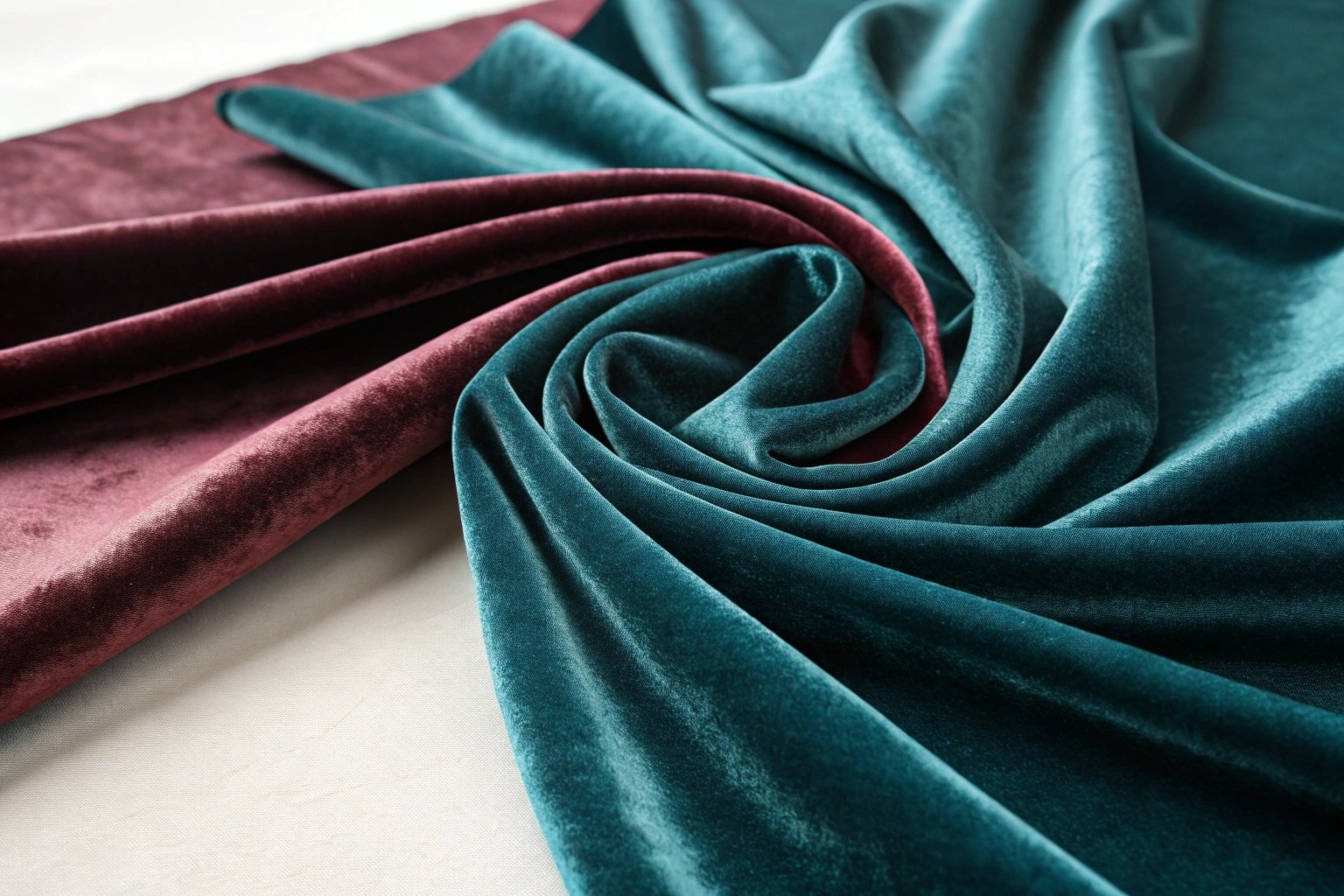Velour fabric is a luxurious textile known for its soft texture and subtle sheen. Often used in high-end apparel and home decor, velour provides a rich, comfortable feel that adds elegance to any product. This fabric is popular for loungewear, jackets, dresses, and upholstery thanks to its unique combination of aesthetic appeal and cozy comfort.

In this guide, we’ll explore what velour fabric is, its key properties, how to care for it, and what designers and customers should be aware of when working with this material.
What Are the Properties of Velour Fabric?
Velour fabric is known for its distinctive softness, stretch, and appearance. It is a knit fabric, which gives it natural elasticity, making it comfortable to wear and versatile in design.
One of its key features is the short pile on the surface, which provides a plush texture and a subtle shimmer when light hits the fabric. This pile is created by cutting looped fibers on the surface of the knit, similar to velvet, but velour is typically softer and more stretchable due to its knit construction.
Velour is also breathable, which makes it suitable for both clothing and home textiles. It retains warmth while allowing air to circulate, adding to its comfort. The fabric holds color vibrantly, offering rich, deep tones that remain attractive over time.
How Do You Care for Velour Fabric?
Proper care is essential to maintain velour’s texture and appearance. While the fabric is durable, the surface pile can become flattened or damaged if not treated correctly.
Washing
Velour is best washed on a gentle cycle with cold water. To prevent the pile from matting, it’s a good idea to turn garments inside out before washing. Avoid using harsh detergents or fabric softeners, as they can degrade the fibers.
Drying
Air drying is recommended to preserve the fabric’s pile. If you use a dryer, opt for a low heat setting and remove the item promptly to avoid wrinkles and flattening.
Ironing
Ironing is generally not recommended for velour, as it can crush the pile. If needed, use a steamer to gently release wrinkles while keeping the fabric’s texture intact.
By following these simple care guidelines, velour garments and home items can maintain their softness and luxurious feel for years.
What Are the Disadvantages of Velour?
While velour offers many appealing qualities, there are some disadvantages to consider.
First, its surface pile is prone to flattening with repeated wear or improper care. Over time, this can make the fabric look worn, especially in areas of frequent contact.
Second, velour is not as breathable as lightweight fabrics like cotton or linen, which means it can feel too warm for hot climates or summer wear.
Velour also requires more careful handling during production. Sewing velour can be challenging due to its stretch and pile, requiring specific techniques and tools to prevent distortion.
Finally, velour may attract lint and dust, which can affect the look of the fabric. Regular brushing or cleaning can help maintain its appearance.
Despite these drawbacks, with proper care and thoughtful use, velour remains a highly desirable fabric for many applications.
What Is Velour Fabric Made Of?
Velour fabric is typically made from a blend of cotton and synthetic fibers, such as polyester or spandex. The cotton content provides softness and breathability, while synthetic fibers add durability, stretch, and resistance to wrinkling.
In some high-end applications, velour can be made entirely from cotton for a more natural feel, but for activewear or performance garments, a polyester-spandex blend is often preferred due to its stretch and shape retention.
The versatility in fiber composition allows designers to tailor velour’s performance characteristics to suit different markets and products—from fashion garments to upholstery to costumes.
How Is Velour Fabric Used in Fashion and Home Decor?
Velour is widely used in both fashion and home decor because of its luxurious texture and visual appeal.
In fashion, velour is popular for tracksuits, jackets, hoodies, and evening wear. Its softness and stretch make it comfortable, while the subtle shine adds a touch of elegance. The fabric’s ability to hold vibrant colors and its plush surface also make it a favorite for stage costumes and theatrical wear.
In home decor, velour is used for upholstery, curtains, and cushions. It provides a warm, inviting feel and adds visual richness to interiors. The fabric’s stretch also allows it to conform well to different shapes, making it ideal for custom upholstery projects.
Designers working with velour should consider the fabric’s handling needs during production and its care requirements for end consumers to ensure the best results.
What Should Brands Know When Using Velour?
For brands considering velour in their collections, it’s important to understand both its advantages and production considerations.
From a marketing perspective, velour communicates a sense of comfort and luxury. It aligns well with product lines aimed at loungewear, premium casualwear, or high-end home goods. The fabric’s ability to elevate basic silhouettes through its texture makes it a valuable tool for creating visually rich collections.
On the production side, velour requires careful cutting and handling to avoid pile distortion. Brands should work with manufacturers who have experience with this fabric. Additionally, providing clear care instructions helps customers maintain the fabric’s look and feel, enhancing overall product satisfaction.
By using velour thoughtfully, brands can deliver products that offer both aesthetic value and exceptional comfort, helping them stand out in crowded markets.
Conclusion
Velour fabric offers a unique blend of softness, shine, and comfort, making it a top choice for fashion garments and home decor. While it requires careful handling and specific care, its luxurious appeal and versatility make it a fabric worth considering for brands aiming to deliver premium experiences.
Understanding velour’s properties, care needs, and applications ensures that both designers and consumers can enjoy the best this beautiful fabric has to offer.

